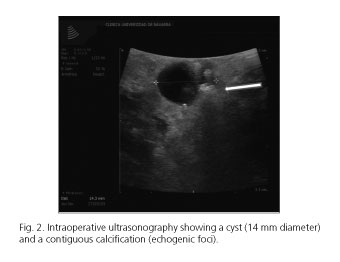My SciELO
Services on Demand
Journal
Article
Indicators
-
 Cited by SciELO
Cited by SciELO -
 Access statistics
Access statistics
Related links
-
 Cited by Google
Cited by Google -
 Similars in
SciELO
Similars in
SciELO -
 Similars in Google
Similars in Google
Share
Revista Española de Enfermedades Digestivas
Print version ISSN 1130-0108
Rev. esp. enferm. dig. vol.109 n.5 Madrid May. 2017
https://dx.doi.org/10.17235/reed.2017.4640/2016
LETTERS TO THE EDITOR
Agenesis of the dorsal pancreas associated with mucinous cysts and chronic calcific non-alcoholic pancreatitis
Key words: Dorsal pancreatic agenesis. Chronic calcific non-alcoholic pancreatitis.
Dear Editor,
Dorsal pancreatic agenesis (DPA) is a congenital malformation which has been described in 107 cases (1,2). Here we present the case of DPA associated with chronic calcific non-alcoholic pancreatitis and mucinous cysts in the residual pancreas.
Case report
A 40-year old male presented with a 20-year history of chronic idiopathic cholestasis, hypercholesterolemia and type 2 diabetes mellitus. When undergoing endoscopic ultrasound, three cystic lesions of 13, 10.5 and 9 mm in diameter with multiple calcifications were observed in the head of the pancreas. Fine needle aspiration biopsy was performed and confirmed the mucinous content and a carcinoembryonic antigen (CEA) value of 2,335 ng/ml and CA-19.9 value of 197.455 U/ml. As a result, the patient was referred for surgery.
Computed tomography (CT) and magnetic resonance cholangiopancreatography (MRCP) confirmed the three cystic lesions with calcifications and the absence of the neck, body, and tail of the pancreas (Fig. 1). Total laparoscopic pylorus-preserving pancreatoduodenectomy was performed. Macroscopic analysis revealed the head of the pancreas with multiple cystic formations with calcifications.
Microscopic analysis showed atrophy of the exocrine pancreas and cystic cavities formed by transitional epithelium without cellular atypia. We also observed amyloid deposits on the endocrine tissue.
Discussion
Since it was first described in 1911 (3), 107 cases of DPA have been reported (1,2). Its diagnosis requires confirmation of the absence of the neck, body, and tail of the pancreas and the duct of Wirsung.
Clinical presentation is highly variable, ranging from incidental discovery through to the development of pancreatic ductal adenocarcinoma. Diabetes together with abdominal pain are the most frequent signs. Recently, an association between DPA and chronic calcific pancreatitis and pancreatic adenocarcinoma has been reported (4). Other studies have reported a link with ampullary adenocarcinoma and intraductal papillary mucinous neoplasm (5).
Javier A. Cienfuegos1, Alberto Benito2 and Fernando Rotellar1
Departments of 1General Surgery and 2Radiology. Clínica Universidad de Navarra.
Facultad de Medicina, Universidad de Navarra. Pamplona, Spain
References
1. Schnedl WJ, Piswanger-Soelkner C, Wallner SJ, et al. Agenesis of the dorsal pancreas and associated diseases. Dig Dis Sci 2009;54:481-7. DOI: 10.1007/s10620-008-0370-3. [ Links ]
2. A Cienfuegos J, Rotellar F, Salguero J, et al. Agenesis of the dorsal pancreas: Systematic review of a clinical challenge. Rev Esp Enferm Dig 2016;108:479-84. DOI: 10.17235/reed.2016.4474/2016. [ Links ]
3. KA Heiberg. Ein Fall von fehlender Cauda pancreatis (bei einem Diabetiker). Centralbl f Allgemeine Pathologie u Pathol Anatomie 1911;22:676-7. [ Links ]
4. Rittenhouse DW1, Kennedy EP, Mascaro AA, et al. The novel triad of dorsal agenesis of the pancreas with concurrent pancreatic ductal adenocarcinoma and nonalcoholic chronic calcific pancreatitis: A case series and review of the literature. J Gastrointest Surg 2011;15(9):1643-9. DOI: 10.1007/s11605-011-1542-6. [ Links ]
5. Sakpal SV, Sexcius L, Babel N, et al. Agenesis of the dorsal pancreas and its association with pancreatic tumors. Pancreas 2009;38:367-73. DOI: 10.1097/MPA.0b013e318196c401. [ Links ]















